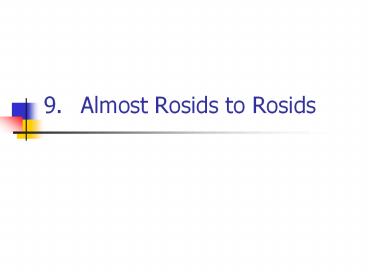9.Almost Rosids to Rosids - PowerPoint PPT Presentation
1 / 18
Title:
9.Almost Rosids to Rosids
Description:
9. Almost Rosids to Rosids Santalales Lots of parasitism Polyacetylenes 1-seeded ovules, pendulous and free-central placentation Molecules In ours, flowers not ... – PowerPoint PPT presentation
Number of Views:79
Avg rating:3.0/5.0
Title: 9.Almost Rosids to Rosids
1
9. Almost Rosids to Rosids
2
(No Transcript)
3
Santalales
- Lots of parasitism
- Polyacetylenes
- 1-seeded ovules, pendulous and free-central
placentation - Molecules
- In ours, flowers not prominent
- Families not on required list
4
Santalaceae
- Hemiparasites
- Root parasites
5
Viscaceae
- Epiphytic parasites
- Haustoria
- Stems jointed
- Lvs opp, oft. Coriaceous or succ.
- Flrs unisex, inconspic, radial
- T3-4A3 (no fil),G3-4, inf. Viscous berry
- Passive gametophyte
- Pantrop some temperate
6
(No Transcript)
7
Loranthaceae
- Us. Epiphytes
- Lv opp or almost so
- Flrs bisex, rad or bilat
- Ca rimCo(3)5-6(9), distinct or conn, oft. Red or
yellow, ACo, opp, fil adnate - Aggr. gametophyte
- Tropical
8
ROSIDS
- Weakly supported group
- Also some lack of clarity of relationships within
- Lots of representatives in our part of the world
- Hypanthium features in many families
- Radial symmetry common
9
Saxifragales
- Some families chiefly (only?) on molecular data
- Hypanthium, 2-united carpels, glandular leaf
teeth - Retained 5-merous flowers with separate parts
10
Saxifragaceae
- Two interpretations Shaw as in text Welsh
much broader (older) - Herbs, often basal leaves, alt. NO STIPULES
- Flr rad to bilat, HYPANTH,
- Ca4-5 sometimes connate, Co4-5, oft. Clawed, St
3-10. G2(-5), connate, varying position, axile,
oft. nectar disk - Fr. Capsule or follicle
11
(No Transcript)
12
Crassulaceae
13
(No Transcript)
14
Geraniales
- Five families, 1 in north Utah
- Morphological features of order
- Leaf margins with glandular teeth
- Inflorescence cymose
- Calyx persistent in fruit
- A few other characters
- Anomocytic stomates
- Vessel elements with simple perforations
15
Geraniaceae
- Remarkable feature is fruit
- Herbs to subshrubs stems usually jointed at
nodes - Hairs glandular, with aromatic oils (I.e., smelly
plants) - Stipules present, leaves with gland. Teeth
- K5C5A(5)10,15, filaments often slightly
connateG5conn - Fruit a schizocarp, persistent style column
16
Persistent style
Note the fruits in picture above and on the right
17
Malpighiales
- This order contains 7.8 of the diversity of
angiosperm diversity - There does not seem a whole lot tying it
together, see http//www.mobot.org/MOBOT/Research
/APweb/welcome.html - The Angiosperm Phylogeny Groups home page
18
Euphorbiaceae

